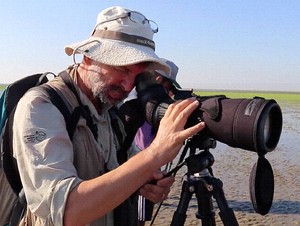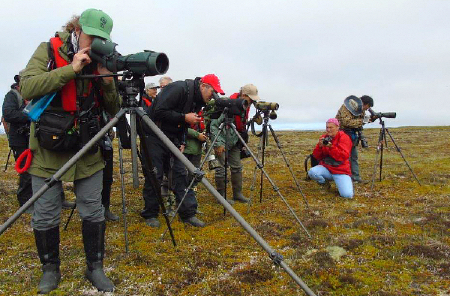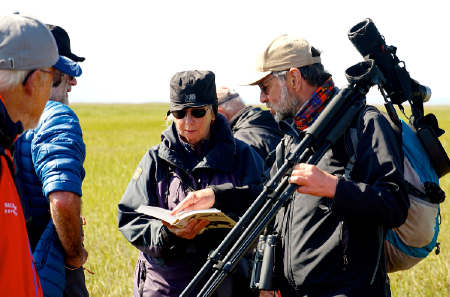25 Feb 2020
Where Kamchatka Tours & Wildlife Conservation Meet
Spoon-billed Sandpipers only breed in Chukotka and northern Kamchatka. The sheer scale of these areas–their remoteness and inaccessibility–has been a huge hurdle for researchers trying to visit potential new breeding sites for these birds. Heritage Expeditions' small vessels are ideal for reaching these extremely isolated coastlines.
Since 2011, we've supported conservation efforts for these Critically Endangered birds by providing Spoon-billed Sandpiper Task Force members transportation on board our Kamchatka expeditions, thereby providing the access needed to investigate potential new breeding sites.
We've also been a BirdLife International Species Champion throughout this time. All funds generated are donated to Birds Russia, the BirdLife partner in Russia. In addition, we are committed to making financial contributions as a company and welcome our guests to join us in support of this programme.

____________________
Protecting the Spoon-billed Sandpiper
By Dr. Christoph Zöckler
Most conservationists and birders will recognise the charismatic face of the Spoon-billed Sandpiper (SBS). Over the past twenty years, international efforts to save this small wader from extinction made global news and the Spoon-billed Sandpiper became an icon in the conservation world. This global fame led to many international supported efforts along its flyway from Russia to China, Myanmar and Bangladesh – a migration distance of nearly 8,000 kilometres!
For the past decade, Heritage Expeditions has supported the conservation work of the Critically Endangered Spoon-billed Sandpiper Task Force in the Russian Far East each summer through their Kamchatka tour, Siberia’s Forgotten Coast: Kamchatka. Starting at the southern tip of the Kamchatka Peninsula in the regional capital Petropavlovsk-Kamchatsky, this expedition cruise travels north, following the picturesque coastline to the wild and rugged shores of Chukotka in northeastern Russia. The dramatic landscape is captivating, rich in colourful tundra flora and punctuated with active volcanoes. The Steller’s Sea Eagle also breeds here, and up to ten species of cetaceans can be seen during the crossing to the Commander Islands.
During breeding season, Spoon-billed Sandpipers reside along coastal tundra areas near lakes, lagoons and marshes of the Kamchatka and Chukotka Peninsulas. Fewer than a hundred pairs of these tiny shorebirds are believed to nest in this region. While the species is restricted to these coastal areas, the 4,500 kilometres long coastline is vast and it’s nearly impossible (and very costly) for researchers to explore each and every suitable habitat. With the help of Heritage Expeditions, SBS Task Force members have been able to reach remote sites, which were previously inaccessible, to search for breeding sandpipers.
In 2017, Heritage Expeditions delivered a new boat and quad bike for the Task Force to assist in their research and, in 2011, they transported 17 healthy chicks and three eggs from the breeding site to Anadyr, where researchers then transported them to a breeding facility at the Wildfowl & Wetlands Trust in Slimbridge, UK.
Spoon-billed Sandpiper Ambassadors Lily Sun (co-founder of the Mangrove Conservation Fund) and Jing Li (NGO Spoon-billed Sandpiper in China) travelled with Heritage Expeditions in 2019 on Siberia's Forgotten Coast: Kamchatka. They are now working to secure and conserve wetlands and mudflats along the East Asian-Australasian Flyway used by Spoon-billed Sandpipers and other migratory waders. These disappearing sites provide crucial pit stops for Spoon-billed Sandpipers, allowing them to safely rest, recover and refuel during their 11,000-kilometre journey from Bangladesh to the Russian Arctic. In addition, the Mangrove Conservation Fund is now providing financial support for a headstarting project in the breeding grounds.
While very few people will ever have a chance to see the iconic Spoon-billed Sandpiper, travellers on Siberia’s Forgotten Coast: Kamchatka will have a first-hand opportunity to see them on their Arctic breeding grounds. Furthermore, Heritage guests will actively assist researchers to look for new breeding sites in previously unsurveyed areas.
While we don’t always find new breeding sites, the SBS Task Force ensures that every Heritage guest onboard views the breeding Spoon-billed Sandpipers during the visit to Meinypil’gyno, the main breeding area in Chukotka. This excursion is often a highlight for most Kamchatka tour travellers. A little fishing village of no more than 600 people has been the base for Birds Russia, the Russian Spoon-billed Sandpiper Task Force Team, for the past 17 years. Situated in the middle of the last known core sandpiper breeding area, Russian and international teams of researchers endeavour on their important conservation work to save one of the globally most threatened waterbirds.
Travellers are welcomed in Meinypil’gyno by the local SBS support team ‘Friends of the Spoon-billed Sandpiper,’ a group of villagers that support the conservation and education work in the fishing village. Two members of Birds Russia and the Russian research team guide travellers through the main breeding area for a chance to see one of the breeding pairs (from a safe distance only). Visitors also learn about village life and are introduced to traditional Chukchi dancing performed by the local dance group.
The collaboration with Heritage Expeditions in Far East Russia has been a win-win situation for both partners and is an outstanding example of effective relationship between a conservation group and the business sector.
We are very grateful for Heritage Expeditions’ support and continuing partnership.
__________________
Travel to Kamchatka with Heritage Expeditions:
Kamchatka Coast: Siberia's Forgotten Coast [14 Days]
22 Jun – 05 Jul 2021
Petropavlovsk-Kamchatskiy to Anadyr, Russia
Charter flights available from Nome, Alaska
Aboard the Spirit of Enderby
Interested in this Kamchatka expedition? Contact us to RECEIVE THE E-BROCHURE.
_______________
Q&A with Dr. Christoph Zöckler
1. When did you first start collaborating with Heritage Expeditions?
CZ: In 2011, I joined Heritage Expeditions on invitation by Rodney Russ (Founder). Later, during the cruise we also picked up two more members of our team Evgeny and Elena, who joined in North Kamchatka. Since then, members of the Spoon-billed Sandpiper Task Force or project supporters have joined Heritage Expeditions in Kamchatka each year.
2. Since working with Heritage Expeditions, how many new Spoon-billed Sandpipers breeding ground sites have been discovered? Approximately how many breeding pairs have been found?
CZ: The Spoon-billed Sandpiper search is a bit like looking for the needle in the haystack; but to the surprise of everyone in 2011 and 2016, a new breeding site was found in both Kamchatka and Chukotka, Russia with Heritage Expeditions! At both sites, we reckon around three pairs each were discovered.


3. How can Heritage Expeditions’ travellers help to protect the Spoon-billed Sandpiper?
CZ: In addition to assisting in the search for these highly threatened waders, Kamchatka travellers can support the Spoon-billed Sandpiper Task Force’s conservation projects through direct donations and the purchase of SBS merchandise to help ensure their invaluable work continues.
Donations can be made online at the following websites:
https://www.eaaflyway.net/project/spoon-billed-sandpiper-task-force/
https://www.m-h-s.org/en/engagement/donations/
4. How has the partnership with Heritage Expeditions impacted your work on SBS conservation?
CZ: Our work with Heritage Expeditions has hugely strengthened our relationship not only with international conservation partners like NABU and other BirdLife partners, but has also helped to improve relations with the Chukotka government.
5. How does your relationship with Heritage Expeditions reflect the new frontier in conservation?
CZ: At a time when nearly one million species are at risk of extinction, wildlife conservation work is now more urgent than ever. This is a tiny but charismatic species, but there are many, many more species at risk. Nature conservation urgently needs more civil partnerships with the corporate side to enhance their efforts to save the ailing biodiversity on this planet.
_________
Dr. Christoph Zöckler
SBS Task Force Coordinator
Manfred-Hermsen Foundation

Christoph has been working in the Russian Arctic for over 25 years and he currently coordinates the Spoon-billed Sandpiper Task Force. He has led several search expeditions to South and SE Asia and the 2012 expedition to Chukotka, Russia. A biodiversity advisor for the Manfred-Hermsen Stiftung (Foundation) and an ecological consultant by day, Christoph has been at the centre of Spoon-billed Sandpiper conservation and research since 2000. Christoph was a key part of the survey team that identified Myanmar, as the key wintering area for Spoon-billed Sandpipers. He has also regularly visited the breeding grounds around Meinypil’gyno. Christoph has contributed much of the research that has helped us understand the dire situation currently facing these birds.









